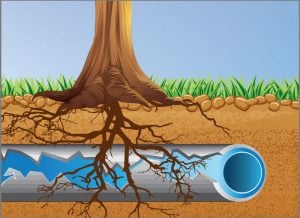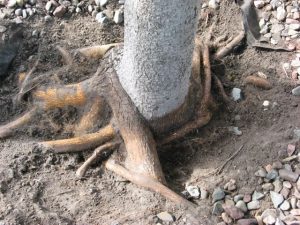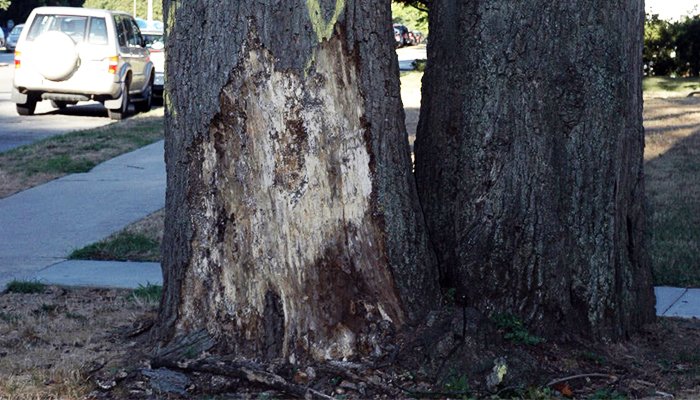Roots play an essential role in a tree’s health and survival. Tree roots have four major roles; absorption of water and nutrients, storage of nutrients and food, anchoring a tree to the ground, and vegetative reproduction.
Since it is the responsibility of tree roots to not only absorb life-supporting nutrients, food, and water, but to also store them, healthy roots are essential to a tree’s survival year-round. Storage of nutrients is particularly important and life-saving during colder/dormant months when nutrients are limited. Additionally, anchoring a tree in the ground (even during severe weather conditions) is only possible with a strong and healthy root system. Most roots (especially the small roots that absorb) thrive near the soil’s surface. When space is available, and the tree roots are healthy, they can spread up to 2-3 times further than a tree’s branches.
When we refer to common problems with tree roots, most of these problems do not center around the tree roots being the initial cause of the problem. Some of these common issues include; tree roots in pipes, roots interrupting pavement, roots interrupting foundation, surface roots, girdling roots, severing roots, and deep planting.
 Tree Roots In Underground Pipes – It is not uncommon for tree roots to grow in, or through underground pipes like a sewer line or water line. But, typically trees penetrate these pipes through existing cracks, unsealed joints, or other fractures/corrosions in the pipes. Roots are designed to seek out water and nutrients that they need to survive. If water or moisture is coming from your pipes, the tree roots will grow towards it. Hair-like roots may enter through small fractures in your pipe and ultimately cause a blockage. Once roots have entered your sewer or water line, rapid growth can occur due to the presence of water and nutrients, which may lead to a burst pipe.
Tree Roots In Underground Pipes – It is not uncommon for tree roots to grow in, or through underground pipes like a sewer line or water line. But, typically trees penetrate these pipes through existing cracks, unsealed joints, or other fractures/corrosions in the pipes. Roots are designed to seek out water and nutrients that they need to survive. If water or moisture is coming from your pipes, the tree roots will grow towards it. Hair-like roots may enter through small fractures in your pipe and ultimately cause a blockage. Once roots have entered your sewer or water line, rapid growth can occur due to the presence of water and nutrients, which may lead to a burst pipe.- Roots Interrupting Pavement – If a tree is planted too close to your pavement surface, roots can crack and lift the asphalt or concrete. Tree roots near pavement are often forced to grow very close to the ground’s surface, as roots will often enter gaps between the soil and pavement to find space to grow. Since this is so close to the surface, it can result in cracked pavement. In some cases, these growing roots are cut to prevent further pavement breakage, but this could be dangerous, as it can weaken and stress the tree. This is particularly worrisome if the tree is close to your home, as it could lead to weakened/hazard tree breakage.
- Roots Interrupting Foundation – Similarly, roots can disrupt a foundation as they do a pavement, but in foundation damage situations, tree roots are often not the cause of the problem. While small roots can penetrate through existing cracks in foundations, they aren’t typically capable of causing mechanical damage through their growth. Soil movement and sinking however, can cause structural damage. Roots can contribute to this indirectly because they may pull water from soil, shrinking it, especially in times of drought.
- Surface Roots – As mentioned previously, major tree roots often grow extremely close to the surface. That being said, there are some things that could cause these roots to become exposed, like frost heave caused by the effects of the freeze-thaw cycle, and soil erosion. If these roots do become exposed, this often leaves them unprotected and vulnerable to mowing wounds and could cause tripping hazards. Two common things homeowners do to remedy this is add soil, or cut the root. But, both of these options can be problematic. Covering the root with soil could lead to depletion of oxygen, and cutting the root could lead to severe stress and lack of nutrient flow. Mulching is typically a better option in this scenario.
 Girdling Roots – Girdling roots refers to when a tree’s roots wrap around the base of its trunk. This can severally hinder the flow of water and nutrients, resulting in dieback and decline.
Girdling Roots – Girdling roots refers to when a tree’s roots wrap around the base of its trunk. This can severally hinder the flow of water and nutrients, resulting in dieback and decline.- Severing Roots – Trees are designed to be well balanced through their entire system. This means that balance must remain between the tree’s crown and its root system. If a tree’s roots are severed or lost for any reason, this creates imbalance, which leads to stress. Severing just one major root of a tree can remove up to 25 percent of a tree’s root system. In situations where a root is severed, extra care should be paid to the tree.
- Deep Planting – If a tree is planted too deep, or too much mulch was applied, this can cause a number of negative and long-term effects on the health of your tree. Some of these effects are; yellowing leaves, premature fall coloration, undersized trees, higher susceptibility to pests, and girdling roots. In some instances of deep planting, the tree can potentially be saved with a root collar excavation, which is essentially removing soil or mulch from against the trunk. However, in some cases replanting or transplanting the tree may be necessary.
If you suspect your tree roots may be dealing with any of these common problems, it’s best to call the professionals before taking action. We can help to foster the health of the trees on your property, avoid future problems, and monitor/provide knowledge on expected root growth to ensure the best placement. Contact Red Cedar today for your free consultation and make sure your root systems are healthy and prepared for the colder/dormant months to come!


